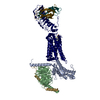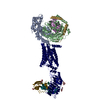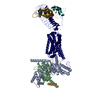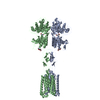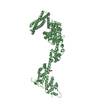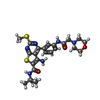[English] 日本語
 Yorodumi
Yorodumi- EMDB-31597: luteinizing hormone/choriogonadotropin receptor(S277I)-chorionic ... -
+ Open data
Open data
- Basic information
Basic information
| Entry | Database: EMDB / ID: EMD-31597 | |||||||||
|---|---|---|---|---|---|---|---|---|---|---|
| Title | luteinizing hormone/choriogonadotropin receptor(S277I)-chorionic gonadotropin-Gs-Org43553 complex | |||||||||
 Map data Map data | ||||||||||
 Sample Sample |
| |||||||||
| Function / homology |  Function and homology information Function and homology information luteinizing hormone receptor activity / choriogonadotropin hormone receptor activity / choriogonadotropin hormone binding / regulation of steroid hormone biosynthetic process / development of secondary male sexual characteristics / luteinizing hormone signaling pathway / luteinizing hormone receptor activity / choriogonadotropin hormone receptor activity / choriogonadotropin hormone binding / regulation of steroid hormone biosynthetic process / development of secondary male sexual characteristics / luteinizing hormone signaling pathway /  follicle-stimulating hormone activity / follicle-stimulating hormone activity /  follicle-stimulating hormone complex / follicle-stimulating hormone complex /  pituitary gonadotropin complex / luteinizing hormone secretion ... pituitary gonadotropin complex / luteinizing hormone secretion ... luteinizing hormone receptor activity / choriogonadotropin hormone receptor activity / choriogonadotropin hormone binding / regulation of steroid hormone biosynthetic process / development of secondary male sexual characteristics / luteinizing hormone signaling pathway / luteinizing hormone receptor activity / choriogonadotropin hormone receptor activity / choriogonadotropin hormone binding / regulation of steroid hormone biosynthetic process / development of secondary male sexual characteristics / luteinizing hormone signaling pathway /  follicle-stimulating hormone activity / follicle-stimulating hormone activity /  follicle-stimulating hormone complex / follicle-stimulating hormone complex /  pituitary gonadotropin complex / luteinizing hormone secretion / follicle-stimulating hormone secretion / positive regulation of steroid biosynthetic process / Thyroxine biosynthesis / Mineralocorticoid biosynthesis / positive regulation of inositol trisphosphate biosynthetic process / Hormone ligand-binding receptors / pituitary gonadotropin complex / luteinizing hormone secretion / follicle-stimulating hormone secretion / positive regulation of steroid biosynthetic process / Thyroxine biosynthesis / Mineralocorticoid biosynthesis / positive regulation of inositol trisphosphate biosynthetic process / Hormone ligand-binding receptors /  Glycoprotein hormones / Reactions specific to the complex N-glycan synthesis pathway / Androgen biosynthesis / follicle-stimulating hormone signaling pathway / ovulation cycle process / female gamete generation / cellular response to gonadotropin stimulus / positive regulation of hormone biosynthetic process / negative regulation of organ growth / cellular response to luteinizing hormone stimulus / male genitalia development / protein targeting to lysosome / G-protein activation / Activation of the phototransduction cascade / : / Glucagon-type ligand receptors / Thromboxane signalling through TP receptor / Sensory perception of sweet, bitter, and umami (glutamate) taste / G beta:gamma signalling through PI3Kgamma / G beta:gamma signalling through CDC42 / Cooperation of PDCL (PhLP1) and TRiC/CCT in G-protein beta folding / Ca2+ pathway / thyroid hormone generation / Activation of G protein gated Potassium channels / Synthesis, secretion, and inactivation of Glucagon-like Peptide-1 (GLP-1) / Inhibition of voltage gated Ca2+ channels via Gbeta/gamma subunits / G protein-coupled peptide receptor activity / G alpha (z) signalling events / Vasopressin regulates renal water homeostasis via Aquaporins / Glucagon-like Peptide-1 (GLP1) regulates insulin secretion / Adrenaline,noradrenaline inhibits insulin secretion / ADP signalling through P2Y purinoceptor 12 / G alpha (q) signalling events / Glycoprotein hormones / Reactions specific to the complex N-glycan synthesis pathway / Androgen biosynthesis / follicle-stimulating hormone signaling pathway / ovulation cycle process / female gamete generation / cellular response to gonadotropin stimulus / positive regulation of hormone biosynthetic process / negative regulation of organ growth / cellular response to luteinizing hormone stimulus / male genitalia development / protein targeting to lysosome / G-protein activation / Activation of the phototransduction cascade / : / Glucagon-type ligand receptors / Thromboxane signalling through TP receptor / Sensory perception of sweet, bitter, and umami (glutamate) taste / G beta:gamma signalling through PI3Kgamma / G beta:gamma signalling through CDC42 / Cooperation of PDCL (PhLP1) and TRiC/CCT in G-protein beta folding / Ca2+ pathway / thyroid hormone generation / Activation of G protein gated Potassium channels / Synthesis, secretion, and inactivation of Glucagon-like Peptide-1 (GLP-1) / Inhibition of voltage gated Ca2+ channels via Gbeta/gamma subunits / G protein-coupled peptide receptor activity / G alpha (z) signalling events / Vasopressin regulates renal water homeostasis via Aquaporins / Glucagon-like Peptide-1 (GLP1) regulates insulin secretion / Adrenaline,noradrenaline inhibits insulin secretion / ADP signalling through P2Y purinoceptor 12 / G alpha (q) signalling events /  regulation of signaling receptor activity / G alpha (i) signalling events / Thrombin signalling through proteinase activated receptors (PARs) / Activation of G protein gated Potassium channels / G-protein activation / G beta:gamma signalling through PI3Kgamma / Prostacyclin signalling through prostacyclin receptor / G beta:gamma signalling through PLC beta / ADP signalling through P2Y purinoceptor 1 / Thromboxane signalling through TP receptor / Presynaptic function of Kainate receptors / G beta:gamma signalling through CDC42 / Inhibition of voltage gated Ca2+ channels via Gbeta/gamma subunits / Glucagon-type ligand receptors / regulation of signaling receptor activity / G alpha (i) signalling events / Thrombin signalling through proteinase activated receptors (PARs) / Activation of G protein gated Potassium channels / G-protein activation / G beta:gamma signalling through PI3Kgamma / Prostacyclin signalling through prostacyclin receptor / G beta:gamma signalling through PLC beta / ADP signalling through P2Y purinoceptor 1 / Thromboxane signalling through TP receptor / Presynaptic function of Kainate receptors / G beta:gamma signalling through CDC42 / Inhibition of voltage gated Ca2+ channels via Gbeta/gamma subunits / Glucagon-type ligand receptors /  alkylglycerophosphoethanolamine phosphodiesterase activity / Adrenaline,noradrenaline inhibits insulin secretion / G alpha (12/13) signalling events / G beta:gamma signalling through BTK / ADP signalling through P2Y purinoceptor 12 / Cooperation of PDCL (PhLP1) and TRiC/CCT in G-protein beta folding / Thrombin signalling through proteinase activated receptors (PARs) / Ca2+ pathway / G alpha (z) signalling events / Extra-nuclear estrogen signaling / G alpha (s) signalling events / G alpha (q) signalling events / photoreceptor outer segment membrane / G alpha (i) signalling events / Glucagon-like Peptide-1 (GLP1) regulates insulin secretion / positive regulation of calcium ion transport into cytosol / arachidonic acid secretion / organ growth / alkylglycerophosphoethanolamine phosphodiesterase activity / Adrenaline,noradrenaline inhibits insulin secretion / G alpha (12/13) signalling events / G beta:gamma signalling through BTK / ADP signalling through P2Y purinoceptor 12 / Cooperation of PDCL (PhLP1) and TRiC/CCT in G-protein beta folding / Thrombin signalling through proteinase activated receptors (PARs) / Ca2+ pathway / G alpha (z) signalling events / Extra-nuclear estrogen signaling / G alpha (s) signalling events / G alpha (q) signalling events / photoreceptor outer segment membrane / G alpha (i) signalling events / Glucagon-like Peptide-1 (GLP1) regulates insulin secretion / positive regulation of calcium ion transport into cytosol / arachidonic acid secretion / organ growth /  spectrin binding / Vasopressin regulates renal water homeostasis via Aquaporins / seminiferous tubule development / G protein-coupled receptor signaling pathway, coupled to cyclic nucleotide second messenger / uterus development / spectrin binding / Vasopressin regulates renal water homeostasis via Aquaporins / seminiferous tubule development / G protein-coupled receptor signaling pathway, coupled to cyclic nucleotide second messenger / uterus development /  peptide hormone binding / thyroid gland development / centriolar satellite / photoreceptor outer segment / positive regulation of calcium-mediated signaling / ovarian follicle development / cardiac muscle cell apoptotic process / activation of adenylate cyclase activity / photoreceptor inner segment / TFAP2 (AP-2) family regulates transcription of growth factors and their receptors / hormone-mediated signaling pathway / positive regulation of release of sequestered calcium ion into cytosol / adenylate cyclase-activating G protein-coupled receptor signaling pathway / peptide hormone binding / thyroid gland development / centriolar satellite / photoreceptor outer segment / positive regulation of calcium-mediated signaling / ovarian follicle development / cardiac muscle cell apoptotic process / activation of adenylate cyclase activity / photoreceptor inner segment / TFAP2 (AP-2) family regulates transcription of growth factors and their receptors / hormone-mediated signaling pathway / positive regulation of release of sequestered calcium ion into cytosol / adenylate cyclase-activating G protein-coupled receptor signaling pathway /  hormone activity hormone activitySimilarity search - Function | |||||||||
| Biological species |   Homo sapiens (human) / Homo sapiens (human) /   Bos taurus (cattle) / Bos taurus (cattle) /   Rattus norvegicus (Norway rat) Rattus norvegicus (Norway rat) | |||||||||
| Method |  single particle reconstruction / single particle reconstruction /  cryo EM / Resolution: 3.2 Å cryo EM / Resolution: 3.2 Å | |||||||||
 Authors Authors | Duan J / Xu P / Cheng X / Mao C / Croll T / He X / Shi J / Luan X / Yin W / You E ...Duan J / Xu P / Cheng X / Mao C / Croll T / He X / Shi J / Luan X / Yin W / You E / Liu Q / Zhang S / Jiang H / Zhang Y / Jiang Y / Xu HE | |||||||||
| Funding support |  China, 1 items China, 1 items
| |||||||||
 Citation Citation |  Journal: Nature / Year: 2021 Journal: Nature / Year: 2021Title: Structures of full-length glycoprotein hormone receptor signalling complexes. Authors: Jia Duan / Peiyu Xu / Xi Cheng / Chunyou Mao / Tristan Croll / Xinheng He / Jingjing Shi / Xiaodong Luan / Wanchao Yin / Erli You / Qiufeng Liu / Shuyang Zhang / Hualiang Jiang / Yan Zhang / ...Authors: Jia Duan / Peiyu Xu / Xi Cheng / Chunyou Mao / Tristan Croll / Xinheng He / Jingjing Shi / Xiaodong Luan / Wanchao Yin / Erli You / Qiufeng Liu / Shuyang Zhang / Hualiang Jiang / Yan Zhang / Yi Jiang / H Eric Xu /   Abstract: Luteinizing hormone and chorionic gonadotropin are glycoprotein hormones that are related to follicle-stimulating hormone and thyroid-stimulating hormone. Luteinizing hormone and chorionic ...Luteinizing hormone and chorionic gonadotropin are glycoprotein hormones that are related to follicle-stimulating hormone and thyroid-stimulating hormone. Luteinizing hormone and chorionic gonadotropin are essential to human reproduction and are important therapeutic drugs. They activate the same G-protein-coupled receptor, luteinizing hormone-choriogonadotropin receptor (LHCGR), by binding to the large extracellular domain. Here we report four cryo-electron microscopy structures of LHCGR: two structures of the wild-type receptor in the inactive and active states; and two structures of the constitutively active mutated receptor. The active structures are bound to chorionic gonadotropin and the stimulatory G protein (G), and one of the structures also contains Org43553, an allosteric agonist. The structures reveal a distinct 'push-and-pull' mechanism of receptor activation, in which the extracellular domain is pushed by the bound hormone and pulled by the extended hinge loop next to the transmembrane domain. A highly conserved 10-residue fragment (P10) from the hinge C-terminal loop at the interface between the extracellular domain and the transmembrane domain functions as a tethered agonist to induce conformational changes in the transmembrane domain and G-protein coupling. Org43553 binds to a pocket of the transmembrane domain and interacts directly with P10, which further stabilizes the active conformation. Together, these structures provide a common model for understanding the signalling of glycoprotein hormone receptors and a basis for drug discovery for endocrine diseases. | |||||||||
| History |
|
- Structure visualization
Structure visualization
| Movie |
 Movie viewer Movie viewer |
|---|---|
| Structure viewer | EM map:  SurfView SurfView Molmil Molmil Jmol/JSmol Jmol/JSmol |
| Supplemental images |
- Downloads & links
Downloads & links
-EMDB archive
| Map data |  emd_31597.map.gz emd_31597.map.gz | 56.5 MB |  EMDB map data format EMDB map data format | |
|---|---|---|---|---|
| Header (meta data) |  emd-31597-v30.xml emd-31597-v30.xml emd-31597.xml emd-31597.xml | 19.8 KB 19.8 KB | Display Display |  EMDB header EMDB header |
| Images |  emd_31597.png emd_31597.png | 65.7 KB | ||
| Archive directory |  http://ftp.pdbj.org/pub/emdb/structures/EMD-31597 http://ftp.pdbj.org/pub/emdb/structures/EMD-31597 ftp://ftp.pdbj.org/pub/emdb/structures/EMD-31597 ftp://ftp.pdbj.org/pub/emdb/structures/EMD-31597 | HTTPS FTP |
-Related structure data
| Related structure data |  7fihMC  7figC  7fiiC  7fijC M: atomic model generated by this map C: citing same article ( |
|---|---|
| Similar structure data |
- Links
Links
| EMDB pages |  EMDB (EBI/PDBe) / EMDB (EBI/PDBe) /  EMDataResource EMDataResource |
|---|---|
| Related items in Molecule of the Month |
- Map
Map
| File |  Download / File: emd_31597.map.gz / Format: CCP4 / Size: 64 MB / Type: IMAGE STORED AS FLOATING POINT NUMBER (4 BYTES) Download / File: emd_31597.map.gz / Format: CCP4 / Size: 64 MB / Type: IMAGE STORED AS FLOATING POINT NUMBER (4 BYTES) | ||||||||||||||||||||||||||||||||||||||||||||||||||||||||||||||||||||
|---|---|---|---|---|---|---|---|---|---|---|---|---|---|---|---|---|---|---|---|---|---|---|---|---|---|---|---|---|---|---|---|---|---|---|---|---|---|---|---|---|---|---|---|---|---|---|---|---|---|---|---|---|---|---|---|---|---|---|---|---|---|---|---|---|---|---|---|---|---|
| Voxel size | X=Y=Z: 1.087 Å | ||||||||||||||||||||||||||||||||||||||||||||||||||||||||||||||||||||
| Density |
| ||||||||||||||||||||||||||||||||||||||||||||||||||||||||||||||||||||
| Symmetry | Space group: 1 | ||||||||||||||||||||||||||||||||||||||||||||||||||||||||||||||||||||
| Details | EMDB XML:
CCP4 map header:
| ||||||||||||||||||||||||||||||||||||||||||||||||||||||||||||||||||||
-Supplemental data
- Sample components
Sample components
+Entire : luteinizing hormone/choriogonadotropin receptor(S277I)-chorionic ...
+Supramolecule #1: luteinizing hormone/choriogonadotropin receptor(S277I)-chorionic ...
+Supramolecule #2: luteinizing hormone
+Supramolecule #3: choriogonadotropin receptor
+Supramolecule #4: chorionic gonadotropin
+Supramolecule #5: Gs proteins
+Macromolecule #1: Engineered Guanine nucleotide-binding protein G(s) subunit alpha
+Macromolecule #2: Guanine nucleotide-binding protein G(I)/G(S)/G(T) subunit beta-1
+Macromolecule #3: Guanine nucleotide-binding protein G(I)/G(S)/G(O) subunit gamma-2
+Macromolecule #4: Lutropin-choriogonadotropic hormone receptor
+Macromolecule #5: Glycoprotein hormones alpha chain
+Macromolecule #6: Choriogonadotropin subunit beta 3
+Macromolecule #7: 5-azanyl-N-tert-butyl-2-methylsulfanyl-4-[3-(2-morpholin-4-yletha...
-Experimental details
-Structure determination
| Method |  cryo EM cryo EM |
|---|---|
 Processing Processing |  single particle reconstruction single particle reconstruction |
| Aggregation state | particle |
- Sample preparation
Sample preparation
| Buffer | pH: 7.4 |
|---|---|
| Vitrification | Cryogen name: ETHANE |
- Electron microscopy
Electron microscopy
| Microscope | FEI TITAN KRIOS |
|---|---|
| Electron beam | Acceleration voltage: 300 kV / Electron source:  FIELD EMISSION GUN FIELD EMISSION GUN |
| Electron optics | Illumination mode: FLOOD BEAM / Imaging mode: BRIGHT FIELD Bright-field microscopy Bright-field microscopy |
| Image recording | Film or detector model: GATAN K3 (6k x 4k) / Average electron dose: 70.0 e/Å2 |
| Experimental equipment |  Model: Titan Krios / Image courtesy: FEI Company |
- Image processing
Image processing
| Initial angle assignment | Type: RANDOM ASSIGNMENT |
|---|---|
| Final angle assignment | Type: MAXIMUM LIKELIHOOD |
| Final reconstruction | Resolution.type: BY AUTHOR / Resolution: 3.2 Å / Resolution method: FSC 0.143 CUT-OFF / Number images used: 413532 |
 Movie
Movie Controller
Controller






